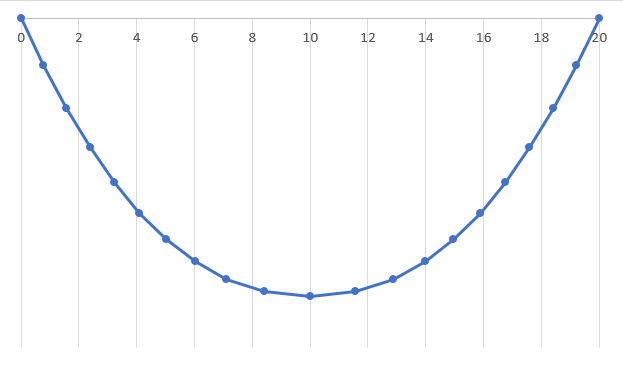21 Masses and 20 Springs
Consider a system consisting of 21 identical point masses and 20 identical springs. They are arranged in a sequential chain as shown in the diagram below. The springs have a natural length of meter and a spring constant of . Gravity is downward. The first and last masses in the chain are fixed in place and cannot move.
At time , the masses have the following properties (all quantities in SI units): The system moves over time until it eventually reaches stasis due to the effects of air resistance. When the system reaches stasis, how far below is the lowest-hanging mass?

Note: Drawing is not necessarily to scale.
Hint: If the prospect of formally solving seems unpleasant, you can instead run a time-domain simulation and see what happens.
The answer is 33.826.
This section requires Javascript.
You are seeing this because something didn't load right. We suggest you, (a) try
refreshing the page, (b) enabling javascript if it is disabled on your browser and,
finally, (c)
loading the
non-javascript version of this page
. We're sorry about the hassle.
Start at the center weight. Draw a freebody diagram, and look at the springs moving left (or right). With θ 1 measured from the horizontal,
F 1 sin θ 1 = 2 m g where m is the mass. Moving left to the second mass,
F 1 cos θ 1 = F 2 cos θ 2 and
F 2 sin θ 2 = 2 3 m g . Then
cot θ 2 = 2 3 m g F 1 cos θ 1 so that
sin θ 2 = F 1 2 cos 2 θ 1 + ( 2 3 m g ) 2 2 3 m g = F 1 2 ( 1 − sin 2 θ 1 ) + ( 2 3 m g ) 2 2 3 m g = F 1 2 + 2 ( m g ) 2 2 3 m g and
F 2 = F 1 2 + 2 ( m g ) 2
Continuing in this fashion we see that
F i sin θ i = 2 ( 2 i − 1 ) m g
F i = F i − 1 2 + 2 ( i − 1 ) ( m g ) 2 = F 1 2 + i ( i − 1 ) ( m g ) 2
F i cos θ i = F i − 1 cos θ i − 1
l i = k F i + l 0 where k is the spring constant and l 0 is the unstretched length.
Now choose θ 1 . Compute F 1 . Compute remaining F i 's, then θ i 's, then l i 's.
Check the constraint ∑ i = 1 1 0 l i cos θ i = 1 0 and iterate the choice of θ 1 accordingly.
When ∑ i = 1 1 0 l i cos θ i = 1 0 , ∑ i = 1 1 0 l i sin θ i = 3 3 . 8 2 6